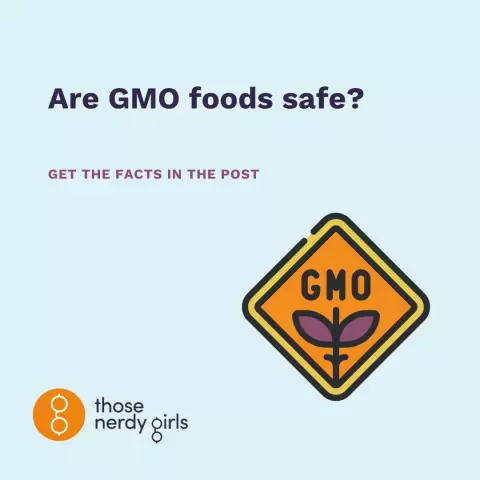- Author Rachel Wainwright [email protected].
- Public 2023-12-15 07:39.
- Last modified 2025-11-02 20:14.
8 myths about GMO foods
Genetically modified organisms (GMOs) are plants or animals (usually agricultural) whose genotype has been purposefully modified. The opposition between supporters and opponents of the inclusion of such organisms in food has always been very acute. In active controversy today, not only scientists and nutritionists are involved, but also many people who are not specialists in this matter.

Source: depositphotos.com
The negative opinion of ordinary people about products containing GMOs is formed under the influence of anti-advertising. Usually it is distributed by manufacturers who are not interested in getting the corresponding product on the market. In the minds of Russians, products containing GMOs are strongly associated with health hazards: about 83% of our country's residents agree that such products should not be consumed. So, there are many misconceptions about them. Today we want to familiarize our readers with the most famous of these myths.
The results of traditional breeding are better and safer than GMOs
Humanity has been engaged in the selection of domesticated animals and agricultural plants since ancient times. The fact that this kind of activity received a theoretical justification did not in any way affect its main methods: the selection of individuals with the properties necessary in the economy, and attempts to enhance these qualities in the offspring by optimal crossing. This is how all existing plant varieties and animal breeds were created. Moreover, scientists engaged in breeding work in the XX century also widely used such a method of changing the genetic apparatus of the original organisms as mutagenesis - provoking mutations using X-ray irradiation or exposure to toxins.
The process of creating genetically modified organisms essentially pursues the same goals. But at the same time, a more effective approach is used, which has become possible due to the development of science and technology. In most cases, the transgenic method is used. Its essence is as follows: the DNA regions responsible for the development of the necessary traits are isolated and incorporated into the genetic apparatus of the organism being changed. The result is the same - animals and plants that have the desired properties.
GMOs, like organisms bred by traditional breeding methods, arise through changes in the genetic apparatus. It's just that in the first case, scientists do not spend too much time on selection, do not work out many unpromising options, so the result is faster and the cost of creating it is lower.
The impact of GMOs on human health is poorly understood
Each GMO knows exactly which part of its DNA has undergone a change and how this affected the final properties. All genetically modified organisms are subject to mandatory certification. It is much easier for scientists to study in detail the consequences of including their tissues in food products than to perform a similar procedure with organisms obtained by traditional breeding methods, in which changes are random.
Modified genes can be incorporated into the human body
Genes (regardless of their origin) generally cannot be "incorporated into the body", getting into it with food. Everything we eat is decomposed in the digestive tract to the elementary molecules of proteins and carbohydrates. Otherwise, it's scary to think about what mixture of plants and animals people would look like.
GMOs contain chemicals that are harmful to humans
In reality, the situation is exactly the opposite. Many genetically modified plants have been bred precisely to exclude toxic substances from the cultivation process. This is how varieties of potatoes appeared in the fields, the tops of which are inedible for Colorado beetles, and corn, with which weeds do not coexist. Eating them in food is absolutely safe, there are several times less harmful chemicals in them than in plants bred by traditional methods. In cotton-growing regions, GMO cotton is actively cultivated today, which is not damaged by the cotton shovel. The fabrics made from it do not contain residues of insecticides that are toxic to humans.
GMO foods have low palatability
Complaints of this kind, as a rule, are caused by berries and fruits, which for a long time were considered seasonal, but are now sold at any time of the year. In fact, their taste has nothing to do with GMOs at all.
The sweetness and unique aroma of everyone's favorite berries (for example, strawberries) are due to the destruction of cell walls and the appearance of sugars in their place. Firms that produce berries on an industrial scale and are interested in long-term storage of products, specially carry out selection in order to select varieties in which the process of such destruction is slowed down. These berries hardly spoil and reach the consumer in excellent condition, but their taste leaves much to be desired.
GMO foods provoke allergic reactions and increase the risk of developing tumors
This is not true. Thanks to genetic engineering, genes responsible for allergenicity have been removed from many plants used for food. Each newly created organism is thoroughly tested for the possibility of provoking allergic reactions.
As for the carcinogenic properties of GMOs, there are still no studies, the results of which would allow to assert that such activity exists. Experiments of this kind have been carried out several times, but the relationship between the increase in the number of tumors and the consumption of foods containing GMOs has never been identified.
GMOs do no good to humanity
GMOs are not fundamentally different from animals and plants obtained through selection or living in the wild. It's just that in traditionally bred species, the necessary qualities are fixed after the selection of randomly arisen changes in the genotype, and in the case of GMOs, these changes are caused purposefully. That is, beneficial (or harmful) qualities are precisely added to the composition of a genetically modified organism.
Using genetic engineering, organisms can be created that solve serious problems. It is enough that there is already an opportunity to grow cereals and vegetables with increased productivity or a composition enriched with vitamins. This is vitally important for those regions of the Earth where the majority of the population in the full sense of the word lives from hand to mouth or eats so monotonously that it is doomed to suffer from diseases caused by a poor diet. Genetically modified plants can conquer areas previously not used for agriculture due to unfavorable climatic or soil conditions.
It is possible that over time, genetic engineering will present people with products that have completely unexpected beneficial properties that will facilitate the solution of energy and other pressing problems.

Source: depositphotos.com
GMO plants are bad for the environment
Any crop plant cultivated on an industrial scale has an impact on the surrounding wildlife. In the case of GMO plants, this effect is more often beneficial than harmful, since many of these organisms do not need chemical protection against weeds, diseases and pests. As for claims that modified plants kill beneficial insects, they clearly belong to the category of horror stories.
The opinion that GMO plants are pollinated with wild species is also highly doubtful. The probability of this is so low that there can be no question of overgrowing the land with varieties that have arisen due to such crossing.
Genetically modified organisms appear as a result of purposeful intelligent activity. The process of their creation and their properties are carefully controlled. Using genetic engineering methods, humanity will be able to solve the problem of hunger, improve the quality of life of millions of people. You should not be afraid of using foods containing GMOs in food: they are not capable of harming health, and in many cases are much more useful and safe than similar food obtained by traditional methods.
YouTube video related to the article:

Maria Kulkes Medical journalist About the author
Education: First Moscow State Medical University named after I. M. Sechenov, specialty "General Medicine".
Found a mistake in the text? Select it and press Ctrl + Enter.






